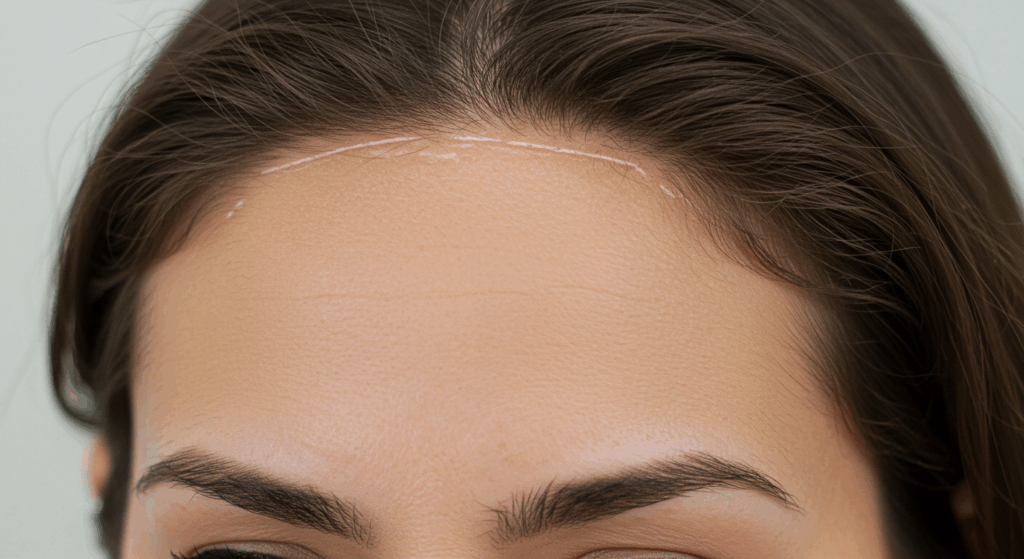Are you exploring Facial Feminization Surgery (FFS) to achieve a more harmonious, feminine appearance? One of the most impactful procedures within FFS is hairline advancement, which can significantly soften the forehead and create a more balanced facial structure. But who is the ideal candidate for this life-changing surgery?
In this comprehensive guide, we’ll explore the key characteristics of an ideal candidate for hairline advancement in FFS, the benefits and risks, and what you need to know to make an informed decision. Whether you’re in the early stages of research or ready to consult a surgeon, this guide will provide the clarity you need.

Table of Contents
Understanding Hairline Advancement in FFS
What Is Hairline Advancement?
Hairline advancement, also known as hairline lowering or forehead reduction, is a surgical procedure designed to reduce the height of the forehead and create a more feminine hairline. This is achieved by moving the hairline forward and, in some cases, reshaping it to better suit the patient’s facial features.
Why Is It Important in FFS?
A high or receding hairline is often associated with masculine facial features. By lowering the hairline, surgeons can create a softer, more youthful, and traditionally feminine appearance. This procedure is a cornerstone of FFS, as it addresses one of the most noticeable areas of gender difference in facial structure.
How Does It Differ from Other FFS Procedures?
While procedures like rhinoplasty or jaw contouring focus on reshaping specific features, hairline advancement targets the proportional balance of the face. It’s often combined with other FFS procedures, such as brow lifts or forehead contouring, to achieve a cohesive result.
For a deeper dive into the differences between FFS and FMS (Facial Masculinization Surgery), check out our article: Contrasting Approaches to Hairline Alteration in FFS and FMS.

Key Characteristics of an Ideal Candidate for Hairline Advancement
1. Facial Structure and Proportions
An ideal candidate typically has a high forehead or a receding hairline, which can create a more masculine appearance. The goal of hairline advancement is to achieve a balanced facial proportion, where the distance between the eyebrows and the hairline is reduced to a more feminine ratio.
2. Hair Density and Quality
Candidates with good hair density and healthy hair follicles are more likely to achieve optimal results. While hair transplants can be used to fill in thinning areas post-surgery, having a strong baseline of hair growth ensures a more seamless outcome.
For more on managing hair growth after FFS, read our guide: How to Manage Hair Growth After FFS.
3. Realistic Expectations
It’s crucial for candidates to have realistic expectations about the outcomes of hairline advancement. While the procedure can dramatically enhance facial femininity, it’s important to understand that results vary based on individual anatomy and healing processes.
4. Overall Health and Medical History
Candidates should be in good overall health and free from conditions that could impair healing, such as uncontrolled diabetes or autoimmune disorders. A thorough medical evaluation is essential to ensure safety and optimal results.
5. Psychological Readiness
Undergoing FFS is a significant decision that requires emotional preparation. Ideal candidates are mentally prepared for the changes and have a strong support system in place.
| Characteristic | Why It Matters |
|---|---|
| High forehead or receding hairline | Creates a more feminine facial proportion |
| Good hair density and quality | Ensures seamless post-surgical hair growth |
| Realistic expectations | Aligns goals with achievable outcomes |
| Good overall health | Promotes safe surgery and healing |
| Psychological readiness | Prepares for emotional and physical changes |
Benefits and Risks of Hairline Advancement in FFS
Benefits
- Enhanced Feminine Appearance: Lowering the hairline creates a softer, more youthful look.
- Improved Facial Proportions: Balances the forehead with other facial features.
- Boosted Confidence: Many patients report increased self-esteem post-surgery.
- Natural-Looking Results: When performed by an expert, the results are subtle and harmonious.
Risks and Complications
As with any surgical procedure, hairline advancement carries potential risks, including:
- Scarring: While surgeons aim to minimize scarring, it’s a possibility, especially in patients prone to keloid formation.
- Hair Loss: Temporary or permanent hair loss can occur around the incision sites.
- Infection: Proper post-operative care is essential to prevent infections.
- Numbness: Temporary numbness or altered sensation in the forehead area is common but usually resolves over time.
For a detailed breakdown of risks, visit our article: FFS Hairline Surgery Risks and Complications.
Recovery Timeline
The recovery process varies, but most patients can expect:
- First Week: Swelling and bruising are common. Patients are advised to rest and avoid strenuous activities.
- 2-4 Weeks: Swelling subsides, and patients can gradually resume normal activities.
- 3-6 Months: Final results become apparent as the hairline settles into its new position.
For more on recovery, see: FFS Hairline Advancement Recovery Timeline.
Non-Surgical Alternatives and Complementary Procedures
Non-Surgical Alternatives
For those who are not ready for surgery or prefer non-invasive options, alternatives include:
- Hair Transplants: Can fill in a receding hairline but do not lower its position.
- Hairline Tattooing: Uses micro-pigmentation to create the illusion of a lower hairline.
- Hairstyling Techniques: Bangs or layered cuts can camouflage a high forehead.
Learn more about non-surgical options: FFS Hairline Lowering Non-Surgical Alternatives.
Complementary FFS Procedures
Hairline advancement is often combined with other FFS procedures for a comprehensive transformation:
- Forehead Contouring: Reshapes the brow ridge for a smoother appearance.
- Brow Lift: Elevates the eyebrows to enhance femininity.
- Rhinoplasty: Refines the nose to better suit the new facial proportions.
For insights into combining procedures, visit: Temple Lift and Hairline Advancement in FFS.
Conclusion: Taking the Next Steps Toward Your Feminine Ideal
Key Takeaways
- Hairline advancement is a transformative FFS procedure that lowers the forehead and enhances femininity.
- Ideal candidates have a high forehead, good hair density, realistic expectations, and good overall health.
- While risks exist, proper pre-operative planning and post-operative care minimize complications.
- Non-surgical alternatives and complementary procedures can enhance results.
Next Steps
If you’re ready to explore hairline advancement, the next steps include:
- Consult a Specialist: Schedule a consultation with a board-certified FFS surgeon to discuss your goals and options.
- Review Before-and-After Results: Examine real patient outcomes to set realistic expectations. See examples here: FFS Hairline Advancement Before and After Results.
- Prepare for Surgery: Follow your surgeon’s guidelines for pre-operative care to ensure a smooth procedure and recovery.
Frequently Asked Questions About Hairline Advancement in FFS
1. How Painful Is Hairline Advancement Surgery?
Most patients report mild to moderate discomfort during recovery, which is manageable with prescribed pain medication. The procedure itself is performed under anesthesia, so no pain is felt during surgery.
2. Can Hair Transplants Be Used After FFS to Fill in Thinning Areas?
Yes, hair transplants can be used to address thinning areas post-FFS. This is often recommended for patients with naturally thin hair or those who experience hair loss after surgery. For more details, see: Can Hair Transplants Be Used to Fill in Thinning Hair After FFS?.
3. How Long Does It Take to See Final Results?
While initial changes are visible within weeks, final results typically take 3-6 months as swelling subsides and the hairline settles.
4. Are There Any Non-Surgical Options for Lowering the Hairline?
Yes, options like hairline tattooing and hairstyling techniques can create the illusion of a lower hairline without surgery. However, these methods do not physically alter the hairline’s position.
5. What Should I Look for in an FFS Surgeon?
Choose a board-certified surgeon with extensive experience in FFS and hairline advancement. Review before-and-after photos, patient testimonials, and ensure they prioritize natural-looking results.
6. How Much Does Hairline Advancement Cost?
The cost varies depending on the surgeon’s expertise, location, and the complexity of the procedure. On average, prices range from $5,000 to $15,000.
7. Can Hairline Advancement Be Combined with Other FFS Procedures?
Absolutely! Many patients opt to combine hairline advancement with procedures like forehead contouring or brow lifts for a more comprehensive transformation.
8. What Are the Signs of a Poorly Performed Hairline Advancement?
Signs of a suboptimal procedure include visible scarring, unnatural hairline shape, or asymmetry. Choosing an experienced surgeon minimizes these risks.
Visit Dr.MFO Instagram profile to see real patient transformations! Get a glimpse of the incredible results achieved through facial feminization surgery and other procedures. The profile showcases before-and-after photos that highlight Dr. MFO’s expertise and artistic vision in creating natural-looking, beautiful outcomes.
Ready to take the next step in your journey? Schedule a free consultation with Dr. MFO ( Best Facial Feminization Surgeon for You) today. During the consultation, you can discuss your goals, ask any questions you may have, and learn more about how Dr. MFO can help you achieve your desired look. Don’t hesitate to take advantage of this free opportunity to explore your options and see if Dr. MFO is the right fit for you.









